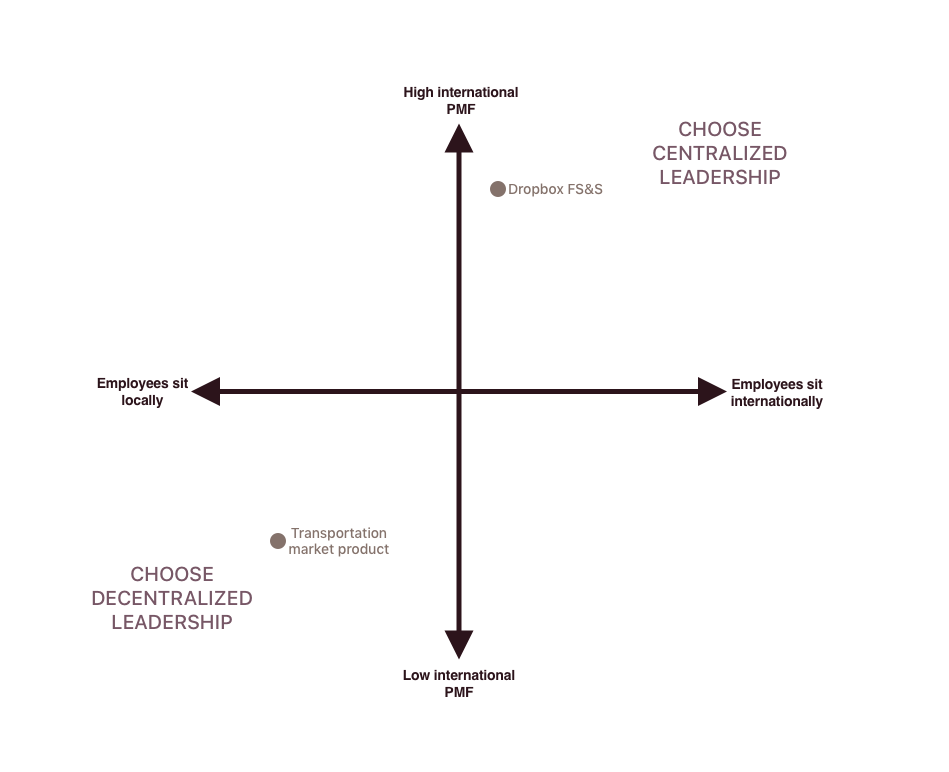Managing Internationally
06 Nov 2022In one of our LEAD classes this past week we discussed global-local tension within Vodafone and had a strong disagreement about what was most “efficient” for a company: allowing certain business lines to run themselves with a decentralized model via a local-first leadership style, or centralizing nearly all operations with a global-first leadership style. I think we weren’t really disagreeing at all, and in fact I think we could agree it depends on the situation. And for that, I have a framework.
It seemed that we universally agreed that the goal of the organization was to be as efficient as possible, meaning highest return on investment (ROI). Returns seemed to solely include financial returns, and investments covered both asset investment and human capital spend.
There are two inputs to ROI, the returns and the investments. Ideally, we have a high ROI and high absolute return. To do this, we need to maximize the return and minimize investments by focusing on external and internal factors.
External factors
On the return side, since we are focusing on financial metrics, we can focus solely on product-market fit (PMF). Along this axis, if the product we are selling has perfect international PMF, there is no need to invest in additional localization. An example of a product that has nearly perfect PMF across companies with higher GDPs include Dropbox’s file sync and store (FS&S) product. The only localization effort we did was in-product translation, sales and marketing specific to that market.
On the other side of the spectrum, a woman in my class worked on a taxi product that originated in Europe and was being applied in India, which required a fundamental restructuring of the product in order to adapt it to a very different transportation market. This required a huge investment in resources in order to find PMF in this new market, but they were rewarded with a higher ROI than if they didn’t invest those resources.
Internal factors
The second axis to consider where the employees for a line of business sit. If employees working on a product sit internationally, the culture and processes ideally should be determined centrally. If employees working on a product it within one office in a culturally dissimilar country, the culture and processes ideally should be determined within that office.
Conflicts
When a product is high PMF internationally and employees sit internationally, one would choose a centralized global leadership style. When a product is low PMF across international borders and employees sit locally, one would choose a decentralized global leadership style. What’s interesting is when a product is high PMF internationally and employees sit locally, it’s not clear which leadership style should be pursued. Same with when a product is low PMF internationally and employees sit internationally.

When employees sit internationally and you have low international PMF, I think the organization suffers and should be restructured. The core benefit of sitting employees internationally is to share information globally, and this won’t help your product if there is low international PMF. You are forcing global collaboration, which is inherently slow due to time zones and lack of face-to-face communication, and opens the team up to possible cultural miscommunications.
When employees sit locally yet a company has high international PMF, I think a company can choose either a global-first or a local-first leadership style and should adapt to how the organization responds to the decision.
Dropbox ran into this situation with their high international PMF Enterprise FS&S product. The employees building the enterprise-focused software sat in Israel, while Dropbox headquarters sat in San Francisco in the United States.
Initially, Dropbox chose to centralize Israeli office hiring, and even though I sat in San Francisco I was on the hiring loop for some of our Israeli product manager recruits. However, we struggled to hire despite interviewing many qualified candidates: what was considered common interview styles in San Francisco wasn’t common in Israel, so many of our recruits did not conform to our expectations for how certain interviews should be passed successfully. After much frustration, I suggested we separate the US and Israeli hiring for product managers, and after adapting our interview processes for this new market we were able to make quite a few successful hires. In this case, it was important to notice what wasn’t working with the centralized hiring function and adapt our policies to achieve our desired goal.